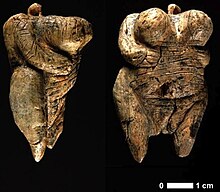
Back Kudjotya ke Hohle Fels AVK Венера от Холе Фелс Bulgarian Venus de Hohle Fels Catalan Venuše z Hohle Fels Czech Venus vom Hohlefels German Αφροδίτη του Χόλε Φελς Greek Venuso de Hohle Fels Esperanto Venus de Hohle Fels Spanish Hohle Felseko venusa Basque Hohler Felsin Venus Finnish
| Venus of Hohle Fels | |
|---|---|
 Two views of the Venus of Hohle Fels figurine, which may have been worn as an amulet, and is the earliest known, undisputed example of a depiction of a human being | |
| Material | Mammoth ivory |
| Size | Height: 6 cm |
| Created | 41.000 years ago |
| Discovered | September 2008 Baden-Wurttemberg, Germany |
| Present location | Blaubeuren, Baden-Wurttemberg, Germany |
The Venus of Hohle Fels (also known as the Venus of Schelklingen; in German variously Venus vom Hohlen Fels, vom Hohle Fels; Venus von Schelklingen) is an Upper Paleolithic Venus figurine made of mammoth ivory that was unearthed in 2008 in Hohle Fels, a cave near Schelklingen, Germany, part of the Caves and Ice Age Art in the Swabian Jura UNESCO World Heritage Site. It is dated to between 42,000 and 40,000 years ago,[1][2] belonging to the early Aurignacian, at the very beginning of the Upper Paleolithic, which is associated with the earliest presence of Cro-Magnons in Europe.
The figure is the oldest undisputed example of a depiction of a human being. In terms of figurative art only the lion-headed, zoomorphic Löwenmensch figurine is older. The Venus is housed at the Prehistoric Museum of Blaubeuren (Urgeschichtliches Museum Blaubeuren).
- ^ "Archäologie erleben - Mission Eiszeit | SWR Geschichte & Entdeckungen". YouTube.
- ^ ""It must be a woman" - The female depictions from Hohle Fels date to 40,000 years ago..." Universität Tübingen. July 22, 2016. Archived from the original on October 11, 2016. Retrieved July 26, 2016.